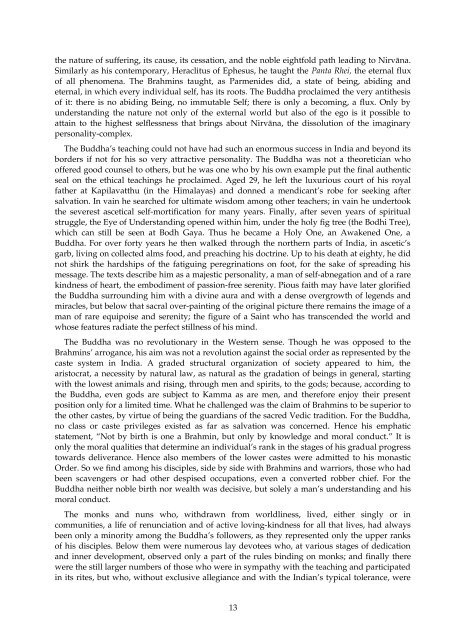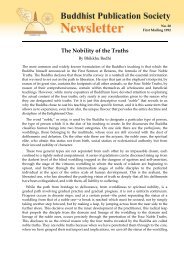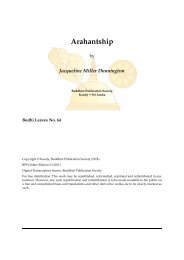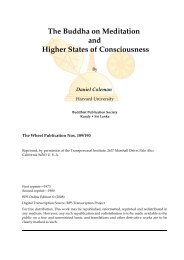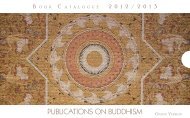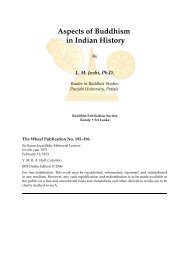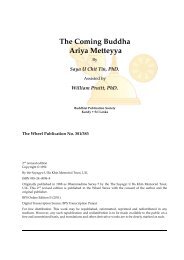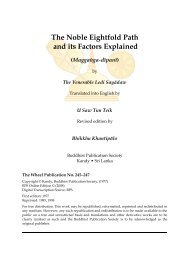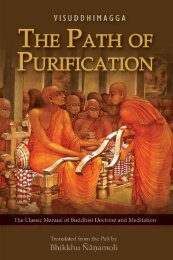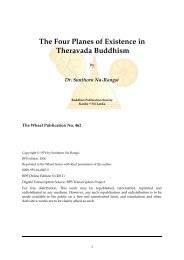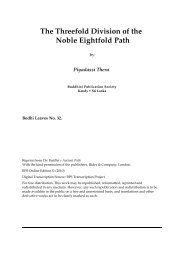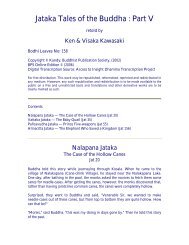Buddhism and Comparative Religion and Other Essays - Buddhist ...
Buddhism and Comparative Religion and Other Essays - Buddhist ...
Buddhism and Comparative Religion and Other Essays - Buddhist ...
You also want an ePaper? Increase the reach of your titles
YUMPU automatically turns print PDFs into web optimized ePapers that Google loves.
the nature of suffering, its cause, its cessation, <strong>and</strong> the noble eightfold path leading to Nirvāna.Similarly as his contemporary, Heraclitus of Ephesus, he taught the Panta Rhei, the eternal fluxof all phenomena. The Brahmins taught, as Parmenides did, a state of being, abiding <strong>and</strong>eternal, in which every individual self, has its roots. The Buddha proclaimed the very antithesisof it: there is no abiding Being, no immutable Self; there is only a becoming, a flux. Only byunderst<strong>and</strong>ing the nature not only of the external world but also of the ego is it possible toattain to the highest selflessness that brings about Nirvāna, the dissolution of the imaginarypersonality-complex.The Buddha’s teaching could not have had such an enormous success in India <strong>and</strong> beyond itsborders if not for his so very attractive personality. The Buddha was not a theoretician whooffered good counsel to others, but he was one who by his own example put the final authenticseal on the ethical teachings he proclaimed. Aged 29, he left the luxurious court of his royalfather at Kapilavatthu (in the Himalayas) <strong>and</strong> donned a mendicant’s robe for seeking aftersalvation. In vain he searched for ultimate wisdom among other teachers; in vain he undertookthe severest ascetical self-mortification for many years. Finally, after seven years of spiritualstruggle, the Eye of Underst<strong>and</strong>ing opened within him, under the holy fig tree (the Bodhi Tree),which can still be seen at Bodh Gaya. Thus he became a Holy One, an Awakened One, aBuddha. For over forty years he then walked through the northern parts of India, in ascetic’sgarb, living on collected alms food, <strong>and</strong> preaching his doctrine. Up to his death at eighty, he didnot shirk the hardships of the fatiguing peregrinations on foot, for the sake of spreading hismessage. The texts describe him as a majestic personality, a man of self-abnegation <strong>and</strong> of a rarekindness of heart, the embodiment of passion-free serenity. Pious faith may have later glorifiedthe Buddha surrounding him with a divine aura <strong>and</strong> with a dense overgrowth of legends <strong>and</strong>miracles, but below that sacral over-painting of the original picture there remains the image of aman of rare equipoise <strong>and</strong> serenity; the figure of a Saint who has transcended the world <strong>and</strong>whose features radiate the perfect stillness of his mind.The Buddha was no revolutionary in the Western sense. Though he was opposed to theBrahmins’ arrogance, his aim was not a revolution against the social order as represented by thecaste system in India. A graded structural organization of society appeared to him, thearistocrat, a necessity by natural law, as natural as the gradation of beings in general, startingwith the lowest animals <strong>and</strong> rising, through men <strong>and</strong> spirits, to the gods; because, according tothe Buddha, even gods are subject to Kamma as are men, <strong>and</strong> therefore enjoy their presentposition only for a limited time. What he challenged was the claim of Brahmins to be superior tothe other castes, by virtue of being the guardians of the sacred Vedic tradition. For the Buddha,no class or caste privileges existed as far as salvation was concerned. Hence his emphaticstatement, “Not by birth is one a Brahmin, but only by knowledge <strong>and</strong> moral conduct.” It isonly the moral qualities that determine an individual’s rank in the stages of his gradual progresstowards deliverance. Hence also members of the lower castes were admitted to his monasticOrder. So we find among his disciples, side by side with Brahmins <strong>and</strong> warriors, those who hadbeen scavengers or had other despised occupations, even a converted robber chief. For theBuddha neither noble birth nor wealth was decisive, but solely a man’s underst<strong>and</strong>ing <strong>and</strong> hismoral conduct.The monks <strong>and</strong> nuns who, withdrawn from worldliness, lived, either singly or incommunities, a life of renunciation <strong>and</strong> of active loving-kindness for all that lives, had alwaysbeen only a minority among the Buddha’s followers, as they represented only the upper ranksof his disciples. Below them were numerous lay devotees who, at various stages of dedication<strong>and</strong> inner development, observed only a part of the rules binding on monks; <strong>and</strong> finally therewere the still larger numbers of those who were in sympathy with the teaching <strong>and</strong> participatedin its rites, but who, without exclusive allegiance <strong>and</strong> with the Indian’s typical tolerance, were13


